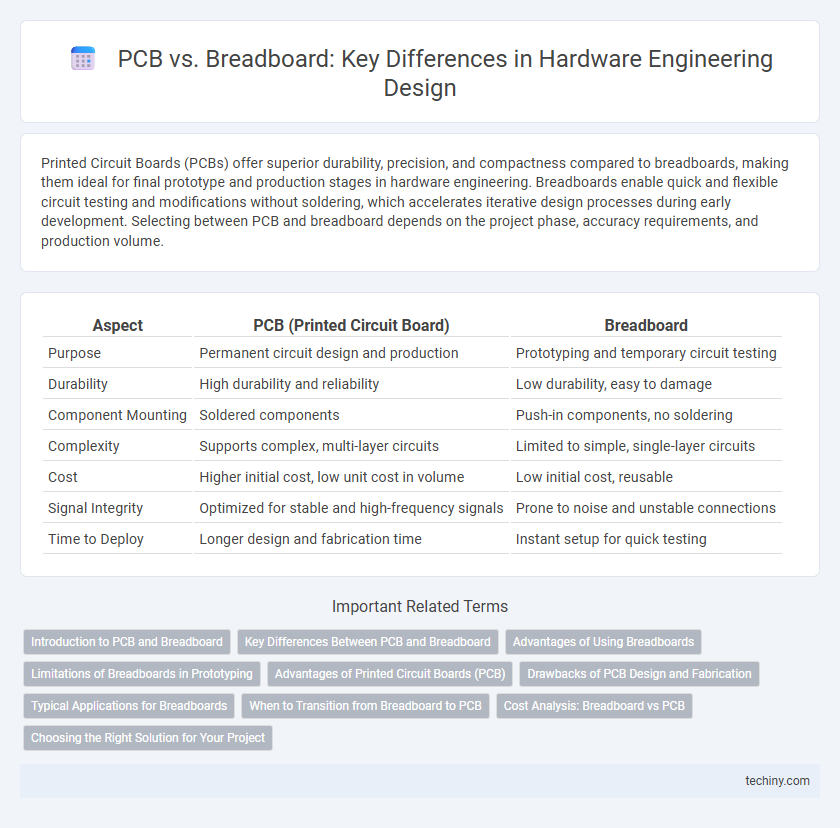Printed Circuit Boards (PCBs) offer superior durability, precision, and compactness compared to breadboards, making them ideal for final prototype and production stages in hardware engineering. Breadboards enable quick and flexible circuit testing and modifications without soldering, which accelerates iterative design processes during early development. Selecting between PCB and breadboard depends on the project phase, accuracy requirements, and production volume.
Table of Comparison
| Aspect | PCB (Printed Circuit Board) | Breadboard |
|---|---|---|
| Purpose | Permanent circuit design and production | Prototyping and temporary circuit testing |
| Durability | High durability and reliability | Low durability, easy to damage |
| Component Mounting | Soldered components | Push-in components, no soldering |
| Complexity | Supports complex, multi-layer circuits | Limited to simple, single-layer circuits |
| Cost | Higher initial cost, low unit cost in volume | Low initial cost, reusable |
| Signal Integrity | Optimized for stable and high-frequency signals | Prone to noise and unstable connections |
| Time to Deploy | Longer design and fabrication time | Instant setup for quick testing |
Introduction to PCB and Breadboard
Printed Circuit Boards (PCBs) are engineered platforms with etched conductive pathways on a non-conductive substrate, designed to mechanically support and electrically connect electronic components. Breadboards are reusable prototyping tools featuring a grid of interconnected sockets that allow components and wires to be inserted for temporary circuit assembly without soldering. PCBs provide permanent, reliable connections ideal for final product designs, while breadboards enable rapid testing and iteration during early development stages.
Key Differences Between PCB and Breadboard
Printed Circuit Boards (PCBs) offer permanent, reliable electrical connections through etched copper pathways, contrasting with breadboards that provide temporary, flexible prototyping via spring-loaded contacts. PCBs support high-frequency signals and complex circuit designs with minimal noise interference, whereas breadboards are limited to low-frequency, less dense circuits prone to connection instability. The durability and professional appearance of PCBs make them essential for final products, while breadboards excel in early-stage testing and quick modifications.
Advantages of Using Breadboards
Breadboards offer rapid prototyping advantages by enabling easy and tool-free circuit assembly without soldering, which accelerates design iterations. Their reusable nature minimizes material costs and supports quick modifications, making them ideal for testing and debugging hardware designs. Breadboards facilitate hands-on experimentation, allowing engineers to verify circuit functionality before committing to printed circuit board (PCB) manufacturing.
Limitations of Breadboards in Prototyping
Breadboards are limited in high-frequency circuit prototyping due to parasitic capacitance and inductance, which cause signal integrity issues and noise interference. Their unreliable connections can lead to intermittent faults, making them inadequate for complex or permanent circuit designs. Breadboards also lack the mechanical robustness and precise layout control essential for professional hardware engineering and scalable production.
Advantages of Printed Circuit Boards (PCB)
Printed Circuit Boards (PCBs) offer superior electrical performance and reliability compared to breadboards, with precise copper traces minimizing signal interference and ensuring consistent connections. PCBs provide compact, durable, and repeatable layouts that enable mass production and enhanced mechanical stability for complex hardware designs. Their customized design support allows seamless integration of surface-mount components, optimizing space and improving overall device efficiency.
Drawbacks of PCB Design and Fabrication
PCB design and fabrication involve high initial costs and lengthy production times, making it less suitable for rapid prototyping compared to breadboards. Errors in PCB layout can lead to costly revisions and delays, as changes require redesigning and manufacturing new boards. Limited flexibility in modifying circuits after fabrication often results in increased development cycles and resource expenditure.
Typical Applications for Breadboards
Breadboards are primarily used for prototyping and testing electronic circuits due to their reusable and solderless nature. They enable rapid experimentation with circuit designs in educational settings, hobbyist projects, and initial hardware development phases. Breadboards are ideal for low-frequency, simple circuit applications but are unsuitable for high-speed or high-power electronics where PCBs offer better stability and durability.
When to Transition from Breadboard to PCB
Transition from breadboard to PCB becomes essential when circuit complexity increases beyond the limitations of prototype setups, ensuring stability and reliability in hardware performance. PCBs provide precise component placement and minimized signal interference, critical for high-frequency or multi-layer circuit designs. Moving to a PCB also facilitates scalability and reduces assembly errors, supporting long-term production and testing efficiency in hardware engineering projects.
Cost Analysis: Breadboard vs PCB
Breadboards offer a low-cost solution for rapid prototyping without the need for manufacturing, making them ideal for initial design validation and small-scale projects. PCBs, while featuring higher upfront costs due to fabrication and assembly, provide long-term economies of scale, enhanced reliability, and compact integration suitable for mass production. Evaluating total project expenses, PCBs reduce labor and error-related costs, whereas breadboards incur minimal initial expenses but may increase costs with complex or iterative designs.
Choosing the Right Solution for Your Project
A printed circuit board (PCB) offers durability, compact design, and reliable electrical connections, making it ideal for final product development and high-frequency applications. Breadboards provide flexibility and ease of prototyping with reusable connections, suitable for experimental setups and quick iterations. Selecting between PCB and breadboard depends on project complexity, production volume, and performance requirements, where PCBs excel in precision and longevity, while breadboards support rapid testing and modifications.
PCB vs Breadboard Infographic

 techiny.com
techiny.com